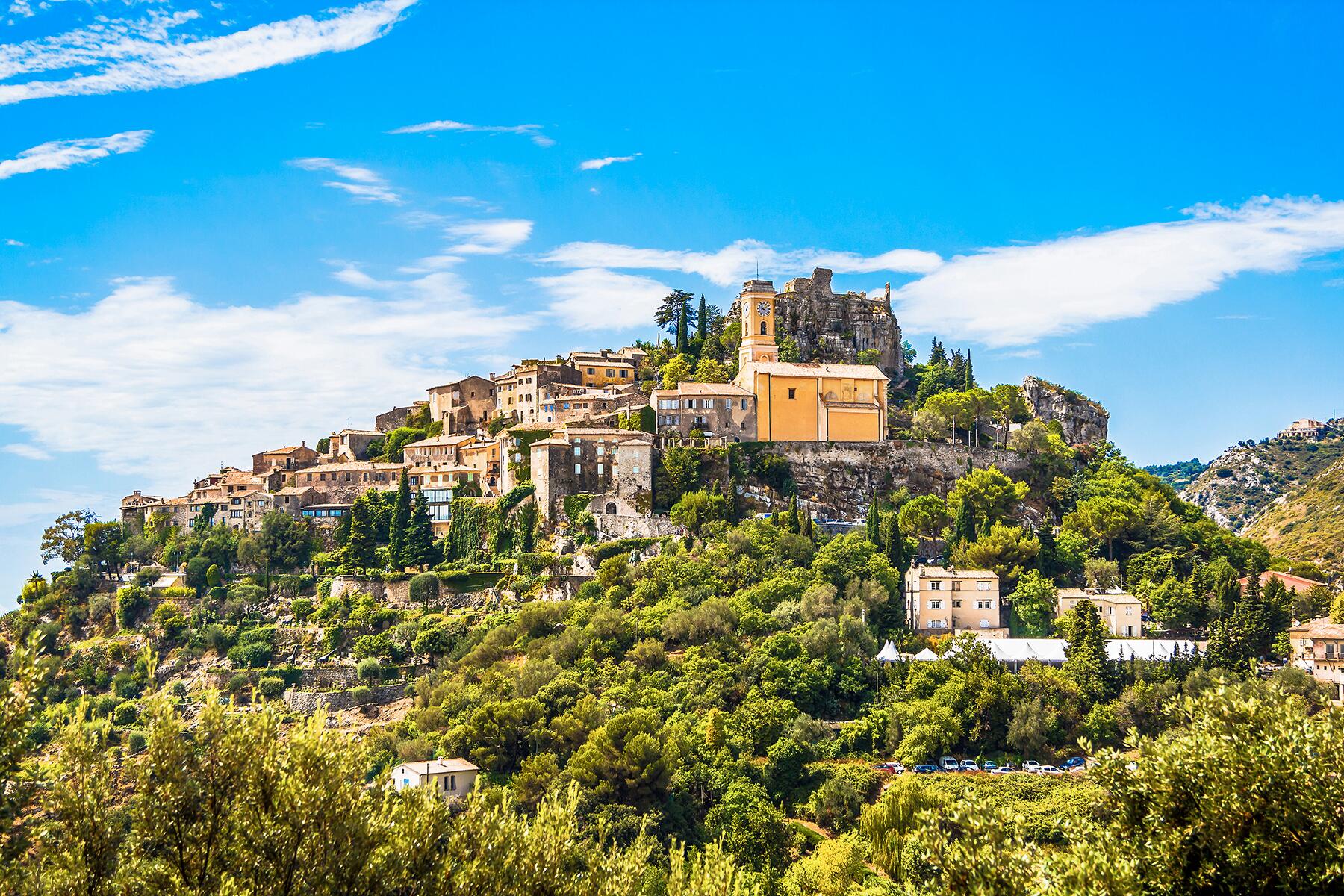It’s no surprise France is home to some of the world’s most charming towns
Nearly everyone has in their mind an idea of the perfect French village. Oozing half-timber houses and rose bowers, these once-upon-a-time towns have a sense of tranquility not even tour buses can ruin. From Normandy to Provence, France has an embarrass de richesses of nestled-away treasures. And while it can be fun to throw away the map and see which villages you stumble upon, here are some of the country’s best.
Ars-en-Ré
WHERE: Charente-Maritimes
This little town in southwest France boasts the largest harbor on the Ile de Re, an area unique for its many salt farms and tidal marshes. The 2,000-strong population swells in the summer, as conservation efforts combined with its seaside beauty make it a natural destination for outdoor activities. You can experience everything from sailing to horseback-riding here. Cycling paths give way to tours of migratory birds and the famous salt marshes. The town also has a few spas for those who just want to take it easy.
Bayeux
WHERE: Normandy
If you are a fan of medieval history, the first thing that pops to mind when you hear the word “Bayeaux” is “tapestry.” Bayeux’s tapestry is one of history’s greatest primary documents, depicting the events leading up to the Norman conquest of England, which culminated in the Battle of Hastings in the 11th century. You can learn about the embroidered cloth at the informative Bayeux Tapestry Museum. The town of 13,600 has a long history dating back to the Roman Empire, when it was a part of the Roman coastal defense, and stretching all the way to World War II and its strategic part in the D-Day invasion. Thanks to heavy fighting in Caen, Bayeux was almost untouched during Operation Overlord. Organize a history guide through the tourist office to get the most out of your visit or take the 74 bus (€2) to the America Gold Beach Museum.
Recommended Fodor’s Video
Cassel
WHERE: Dunkirk
Located on top of a prominent hill (Mont Cassel) and overlooking the rolling pastures of French Flanders, this town has a history dating back to ancient Europe, but most people know it for the role it played in the Battle of Dunkirk during World War II. For three days in May 1940, British troops put up a brave defense against German forces while the British army tried to evacuate France. In the ensuing battle, much of the cobblestone town and its traditional Flemish buildings were reduced to rubble and most of the British soldiers who stayed to fight were killed or captured. Today, the Musée de Flandre is dedicated to Flemish art, Flanders fields, and the battle itself. Don’t forget to check out “the rooms” at the Mont des Récollets gardens.
Chinon
WHERE: Loire Valley
Located seemingly in the middle of nowhere, the town of Chinon was once the center of French life in the Middle Ages. Less than a thousand years ago, when rivers were the highways of medieval Europe, Chinon’s position on the Vienne River gave it access to the Loire River, the seaport of Nantes, and the Ile-de-France region right outside of Paris. The natural rocky outcrop on the northern bank provided a natural fort, and today the village of 8,000 provides stunning views of the surrounding countryside. Also the site of a former royal residence during the Middle Ages and the Renaissance, the cobblestone streets have been trodden by the likes of Joan of Arc, the Knights Templar, and Richard the Lionheart. Today, it makes for a peaceful weekend getaway with its several restaurants, a Sunday market, and an easy-drinking cherry-red Chinon wine made from local Cabernet Franc grapes.
Cluny
WHERE: Burgundy
Located in the central part of France, Cluny was founded in 910 around a Benedictine Abbey, which naturally remains one of the town’s main tourist attractions. Use Cluny as a home base to visit the surrounding 16 medieval fortresses and castles of the Renaissance, Baroque, and Classicism periods, some of which serve as hotels, wineries, or museums. They are all part of the Route des Chateaux in Southern Burgundy, otherwise known as the Bourgogne Sud (pick up a free map at the tourism office or download one online). Just outside of Cluny, the landmark caves of Azé have the greatest concentration of prehistoric bear skeletons in the world.
Collonges-La-Rouge
WHERE: Corrèze
When the monks of Charroux Abbey founded a priory in the 8th century, peasants and tradesmen alike prospered here and found safety behind the walls. It wasn’t until pilgrims began to come as part of the famed Way of St. James that the town secured a lasting source of revenue. But by the 19th century, the population was so low, the village was transformed into a stone quarry. With its distinctive colored architecture due to the area’s unique red sandstone, locals were able to get the entire village declared as a historical monument at the beginning of the 20th century. No wonder it’s considered one of the most beautiful villages in all of France today.
Cordes sur Ciel
WHERE: Midi-Pyrenees
Ciel is the French word for sky so this town is quite literally in the clouds, which is probably why it won the Preferred Village of France in 2014. Situated on a small mountain, the town became an important defensive position for local inhabitants during the Middle Ages, with its walls and rocky heights not only protecting the townspeople but the local architecture, too. This same architecture offers present-day visitors some of the best examples of 13th- and 14th-century Gothic architecture in the country. The outdoor market and the Museum of the Art of Sugar and Chocolate are also worth visiting.
Domme
WHERE: Dordogne
In 1307, hundreds of members of the Knights Templar were locked up here in the town of Domme. The medieval walls still bear their coded graffiti today, a distinctive series of geometric figures designed to represent the Holy Grail and the Cross. Inside the village, classified as one of the most beautiful in France, the 11th-century bastide acts as the entrance to the Grottes de Domme, a series of huge caves under the town that sheltered residents during the Hundred Years’ War. Positioned high above the scenic Dordogne River, the best views from Domme can be found at Belvedere de la Barre, the start of a walk to the public garden.
Étretat
WHERE: Normandy
England may have the white cliffs of Dover, but France has the white cliffs of Étretat. If you’re up to it, make a trek on the “Falaises et Valleuses du Pays de Caux,” the 5½-mile hiking path that passes through the town from Le Havre to Le Treport. From this route, you can see Étretat’s coastline and its three natural arches, with the tallest clocking in at 230 feet. Étretat also plays a part in one of aviation’s greatest mysteries. On May 8, 1927, L’Oiseau Blanc (The White Bird), a custom-built torpedo bomber Levasseur PL.8, took off from Paris Le Bourget airfield. The plane was headed for New York and hoping to be the first nonstop transatlantic flight between the two cities. This was the last place it was seen before crossing the Atlantic and a chilling monument and museum tell the story of the two pilots and their disappearance.
Éze,
WHERE: French Riviera
When you get off at the beachside Éze train station, you might wonder where exactly the town even is. Just look up … way up. Take the shuttle or climb the steep Nieztsche Path (90 minutes) to make it to this perched town. It’s worth the sweat for the panoramic views, especially from the Exotic Botanical Garden (located 950 feet above sea level), with its sculptures by Jean-Philippe Richard and a Neoclassical 18th-century church. The medieval village has been wonderfully preserved, with the addition of the Fragonard perfume factory and the two-Michelin-starred restaurant Chevre d’Or. For cyclists, the Col d’Eze route has an even more impressive view of the area from a regional park.
Gordes
WHERE: Provence
Known as the lighthouse of the Luberon, this gravity-defying perched village has a history that dates back to the Roman Empire. During World War II, the town was a hotbed of Nazi resistance and suffered violent reprisals in 1944 after a German patrol was attacked in the early days of Operation Dragoon. Because of this, the German army fired on civilian homes and by the end of the war, 33 of the town’s residents had been killed. With such spectacular vistas, festivals, museums, and restaurants, you’d never guess this tiny cobblestone town has such a heartbreaking history. Just steps from the town center, the architectural masterpiece known as the Village des Bories is a listed historical monument.
Kaysersberg
WHERE: Alsace
France won Kaysersberg in a tug of war with Germany that started after the Franco-Prussian War and ended with World War II. A scenic walk along Rue General de Gaulle (a subtle nod to the town’s German heritage) gives you a glimpse of the 13th- to 15th-century Church Ste-Croix, as well as the house of Nobel Peace Prize winner Albert Schweitzer. Yet it’s the painted half-timber buildings that captivate the most, especially as you cross the 16th-century fortified stone bridge over the Weiss River. As part of the Alsace Wine Route, Kaysersberg produces some of the world’s best Pinot Gris.
L’Isle sur la Sorgue, Vaucluse
WHERE: Provence
After Paris, this exquisite island city is France’s largest antiques center and the third largest brocante (vintage market) in Europe. Unlike many small French towns, this one and its 300-plus antiques outlets have seen its population rise in the past 50 years. The biannual Grand Déballage (“Great Unpacking”) is held for four days around Easter and in mid-August, and attracts bargain hunters from across Europe. The Sunday antiques/vintage market, which supposedly dates back to 1596, is the best in France. And there’s the delightful bonus of a waterwheel setting along the Sorgue River, which, in the 12th century, served as a natural protective moat; in successive years, it powered the town’s mills and acted as a natural highway for trade.
Riquewihr
WHERE: Alsace
Located close to the German border, Riquewihr is remarkably one of the few towns in the area unscathed by World War II. Largely considered one of the most beautiful towns in France, it’s filled with medieval fortifications. You can visit the Thieves’ Tower in the former prison or Monkey Mountain, a wildlife refuge for Barbary macaque monkeys. But let’s face it, you’re most likely here for the wine. From 1575 until the early 17th century, it was illegal to cultivate anything other than noble vine stocks here, and the area produced some of the most famous wines of the Holy Roman Empire. Located on the Alsace Wine Route, the town today has several wineries and many restaurants.
Rochefort en Terre
WHERE: Brittany
Rochefort was put on the map in the early 20th century after wealthy French-born American painter Alfred Klotz bought the local château in 1907. Defenders of the French Republic had destroyed the 12th-century château in 1793, leaving behind only the facade; the current building was constructed by Klotz himself. Open from May to September, the château houses some of Klotz’s paintings as well as a collection of objects from rural life in times past. Today, this little town of character is littered with artists and craftspeople, including potters, a candle maker, and a toymaker, but don’t leave without a stop at Le Rucher Fleuri on Rue du Porche; the artisan biscuit maker is famous for its pain d’épices.
Roussillon
WHERE: Provence
Located in the Luberon, the russet-red town of Roussillon is located in the heart of one of the biggest ochre deposits in the world. Until 1930, thousands of people were employed in the mining of the natural clay, which has since been banned to preserve the surrounding countryside. However, one of the former quarries can be visited via a 60-minute walk through the Sentier des Ocres. Commercially, the town is now part of France’s largest wine-producing region, the Languedoc-Roussillon, with 300,000 hectares of vineyards running from the Rhône Valley to the Spanish border.
St-Cirq-Lapopie
WHERE: Dordogne
Every year, some 400,000 visitors descend on this hard-to-get-to village with a population of just 207. Part of the reason is that the town won the popular vote on a French television program “Favourite Village of the French” in 2012. It’s also located along the French pilgrimage route for the Way of St-James. But mostly, the majestic town perched high above the Lot Valley is truly one of the most beautiful villages in France—you actually access the town from above and wind your way down along the cobblestone streets.
Trébeurden
WHERE: Brittany
This tiny town of 3,800 boasts a stunning beach facing the English Channel and thanks to its location on the northwestern coast of France, your chances of getting sunburn are slim. Another jewel of the area is the 18-mile Côte de Granite Rose, a unique rose-color pink-sand and stone granite seashore that wraps around Trébeurden. If you’re looking for something more active, the area also has several scenic but not overly challenging hiking trails that wind along the coast and its forested interiors.
Troyes
WHERE: Champagne
Located in the northeastern part of France, Troyes is the city of a thousand colors, due to its preserved multicolor timber-frame houses from the Middle Ages and the Renaissance. A fire in 1524 ravaged many of the homes, but since residents were mostly wealthy merchants, they had the means not only to rebuild but also to make all efforts to prevent another disastrous blaze. In addition to its rainbow of facades, Troyes is home to 10 notable historic churches, one of the highest per-capita rates in France. The churches are a result of the town’s position as a key trading city during the Middle Ages. In fact, the standard measurement of gold—12 troy ounces make a troy pound (373.24 g)—evolved here. If architecture’s not your thing, Troyes is also the headquarters of the crocodile-crested Lacoste brand, so it’s no surprise several outlet malls have recently popped up in the area.
Vienne
WHERE: Rhone Valley
Located just south of Lyon, Vienne has a history that predates the Roman Empire. It was a significant capital for the Gallic people and later was a major center for the Roman Empire. In fact, the town still features two outstanding Roman remains: the temples of Augustus and Livia, which were associated with the city’s Roman circus. In 2017, the most exceptional excavation of a Roman site in nearly 50 years was discovered here. A fire had prompted the Romans to abandon it, leaving behind what was basically a miniature Pompeii. For music lovers, the Vienne Jazz Festival in July is a popular event.




